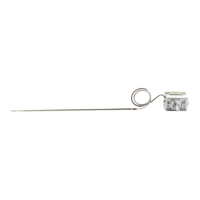product operating instruction
E.G.O. Germany (E.G.O. Elektro-Gerätebau GmbH)
document id.: 90.60145.653-001-02-A / state: 230 - released
designation: Thermostats 55.xxxxx.xxx / 56.xxxxx.xxx
2.3.12 Failing below the minimum switching power
Failing below the minimum switching power may lead to faults in the switching function.
Make sure that the switching capacities are not falling below the value noted in the specified
technical data.
2.3.13 Exceeding the maximum number of switching cycles
Exceeding the maximum number of switching cycles may lead to malfunctions.
Make sure that the number of switching cycles specified in the technical data is not exceeded.
2.3.14 Aging (thermal cut-outs and temperature limiters)
Thermal cut-outs and temperature limiters age in normal operation even with regular cycle loads. Aging
may lead to malfunctions.
Change thermal cut-outs and temperature limiters prophylactically in the following cases:
– The temperature controller fails
– Exceeding the maximum sensor temperature
– After 10 years at the latest
2.3.15 Deviating switching temperatures and hysteresis
Switching temperatures and hysteresis specified in the type drawing apply in accordance with E.G.O.
measuring method (at room temperature of 23 °C, temperature change 1K / min in the E.G.O. factory
standard bath). In the case of deviating room temperatures and temperature changes, the actual
switching temperatures and hysteresis may differ from the information in the type drawing.
When designing the application, note the correction factors in the type drawing.
Carry out a series of tests with thermostats in the respective application and compensate for the
measured temperature differences if necessary.
2.3.16 Uneven heat distribution on the sensor
Uneven heat distribution on the sensor may lead to malfunctions or even destruction of the thermostat.
Note the following points when designing the application:
– The heat distribution on the sensor should be as even as possible.
– The sensor must be surrounded by the measuring medium over its
entire length.
Carry out a series of tests with thermostats in the respective application and compensate for the
measured temperature differences if necessary.

